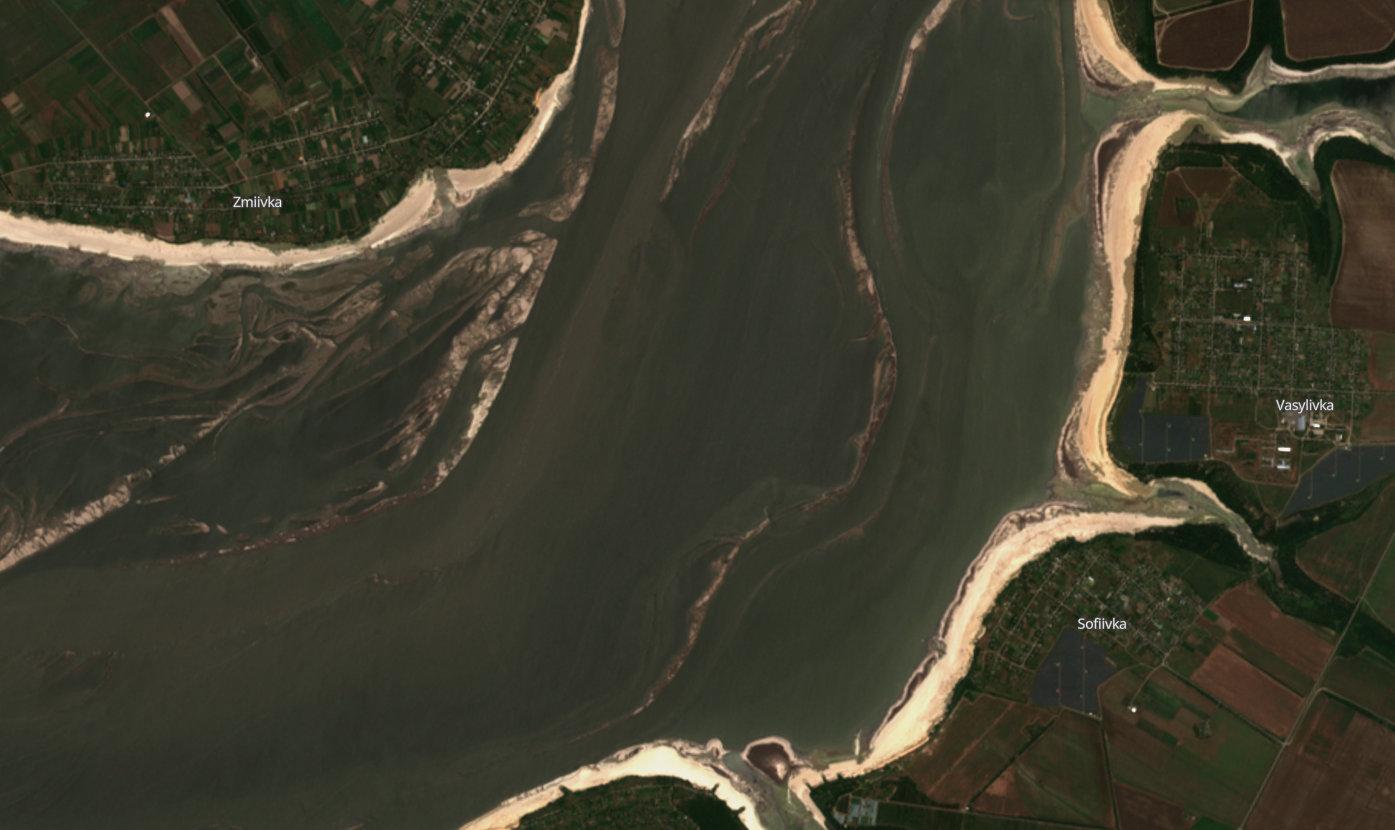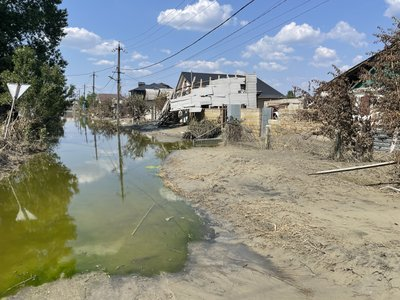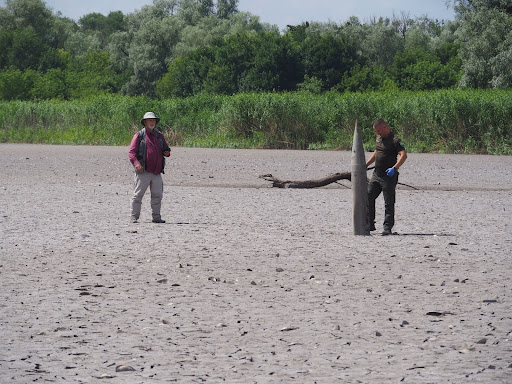Oleksiy Vasyliuk
The destruction of the dam at the Kakhovka hydropower plant on Ukraine’s Dnipro River in June 2023 caused not only a huge humanitarian crisis, but also an environmental catastrophe. Sediment samples collected from the former Kakhovka Reservoir show that over the decades, toxic deposits had accumulated on the bed of the reservoir as a result of the discharge of untreated wastewater from heavy industry upstream. Following the destruction of the dam, these deposits – including toxic elements such as lead, arsenic and zinc – were carried downstream threatening the ecosystems of the Dnipro and surrounding areas. Oleksiy Vasyliuk looks at how the pollution of soils and bottom deposits in the Kakhovka Reservoir is impacting the environment and local ecosystems, and asks what conservation measures need to be taken to prevent their further spread.
Occupying an area of over 2,000 square kilometers, the Kakhovka Reservoir was the final link in a hydroelectric cascade on the Dnipro River built during the Soviet era. The reservoir, which could hold up to 18.6 cubic kilometers of water, collected water from the entire cascade, creating a kind of reserve for irrigating the region in the summer period.
In the last 68 years agricultural activity in the south of Ukraine has depended significantly on the supply of water from the Kakhovka Reservoir. A year after the reservoir vanished when a hole was blown in the dam, allegedly by Russian troops, the region has adapted to the new conditions relatively well, using alternative sources of water supply and power generation. Three water pipelines were built to meet the needs of the population and industry, while the industrial enterprises of the Dnipro region and the Zaporizhzhia Nuclear Power Plant receive water from underground sources.
Over the course of decades, pollutants from all the reservoirs located upstream, as well as from agricultural lands along its shoreline, entered the “Kakhovka Sea,” where they settled to the bottom, remaining in the reservoir rather than being carried downstream into the Black Sea. Heavy metals and other toxic substances accumulate in bottom deposits and can migrate into the food chain, creating a long-term threat of serious diseases and they are generally indicators of a dangerous, polluted environment. The main sources of the pollution are sewer networks and industrial treatment facilities that are in unsatisfactory technical condition and do not ensure complete water purification.
More than 400 industrial and agricultural sites were located on the shores of the Kakhovka Reservoir, discharging 6.1 million cubic meters of wastewater daily. Every year, enterprises in the city of Zaporizhzhia would dump 282 million cubic meters of untreated or insufficiently treated wastewater into the upper part of the Kakhovka Reservoir (for example, Dniprospetsstal, and other coke, chemical, aluminum and hardware plants discharge 20.9 million cubic meters of wastewater annually). In the Dnipro region, the main polluters of the Kakhovka Reservoir were industrial enterprises in the city of Nikopol, which discharged more than 50 million cubic meters of wastewater annually, including 47 million cubic meters of contaminated water.
As early as 1952, scientists were predicting that an accumulation of industrial and domestic wastewater from surrounding settlements would cause excessive water pollution in the Kakhovka Reservoir. But sufficient measures to limit pollution were not taken, and treatment facilities in the Dnipro River basin have proven ineffective in cleaning wastewater to safe levels.
The alkaline environment that typically forms in bottom sediments facilitates the binding and sedimentation of toxic substances. This means they tended to accumulate at the bottom of the reservoir, preventing them from being carried further downstream. Pollutants accumulated in bottom sediments on the reservoir bed in large quantities, as well as in the bodies of Dreissena polymorpha mollusks (Zebra mussels), which are unable to filter large volumes of water.
An act of sabotage
Тhe dam sabotaged at the Kakhovka hydropower plant on June 6, 2023 caused the most destructive short-term impact on the environment in Ukrainian history, leading to significant economic losses and the destruction of important ecosystems that are critical for biodiversity. The explosive sabotage of the dam is regarded by many international organizations and governments and civil society as an act of ecocide.
The reclamation infrastructure of the Kakhovka hydroelectric complex has been destroyed, and most of the surrounding irrigated land is now mined or contaminated with toxic substances (including heavy metals), which means it will be impossible to use even after the end of the war.
The destruction of the dam was a large-scale environmental disaster that radically transformed the regional ecosystems that had formed during the reservoir’s existence. Three key zones have been affected by the changes: the bed of the former reservoir, areas downstream that suffered from flooding, and the northwestern part of the Black Sea.
However, of all the environmental consequences of the catastrophe, it is the pollutants (heavy metals and other toxic compounds) that had accumulated at the bottom of the reservoir in the past that pose the greatest long-term threat.
Read more: Sabotage of the Kakhovka Hydropower Plant: What are the environmental consequences?
Sediment spreads after the disaster
In the 70 years following the filling of the Kakhovka Reservoir, a significant volume of silt (bottom sediments) was deposited on its bed, forming a deep layer of sludge. Although it was 17.6 cm thick on average, the depth of this layer varied, depending on the relief of the reservoir bed and water circulation, reaching up to one meter in depth in some spots.
We do not know how much of this silt was washed out as the reservoir emptied and then deposited in flooded areas. As water flowed out of the reservoir, water drained rapidly from shallower parts of the bed into deeper areas. This caused silts to wash horizontally into deeper areas (branches and channels) and then into the main channel and beyond into the lower reaches of the river, and ultimately the Black Sea. Silt accumulated in a more concentrated form in a swampy area in the eastern section of the former reservoir, where, as the water level fell, a large isolated water body formed. More silt entered this “lake” as the draining waters moved through the area.The pollution of the former Kakhovka Reservoir with toxic deposits is now having a negative effect not only on the land occupied by the reservoir, but also on those zones where large amounts of silt accumulated since the destruction of the dam. Within just 24 hours of the explosion, a band of water full of suspended matter was visible in the main channel of the Dnipro, extending along the fairway. Soon the whole stream of water escaping from the dam was filled with suspended sediment that had built up on the reservoir bed over many years and had now been disturbed.

Representatives of the Ukrainian Nature Conservation Group (UNCG) observed that as the water flow and flood levels began to subside, the concentration of suspended solids and pollutants continued to grow. By now, waste from the destruction of man-made structures and dumps was adding to the mix. Now the most polluted sediments – those that were deposited last – were now the topmost, secondary layer.
When the flow rate decreased where the delta widened and discharge slowed, alluvial deposits built up, emerging as water levels fell. These deposits were up to 70 cm deep in some places, even in the city of Kherson. Significantly larger volumes are likely to have settled in vegetation in the part of the Dnipro delta adjoining the left bank.

New soils form
After the reservoir’s destruction and the disappearance of a large amount of silt from its former bed, soils characteristic of river floodplains began to form on the exposed bottom. Formed from a mixture of different types of sandy and silty bottom sediments, their character depends on the structure of the bed, as well as the speed of the water flow.
The best base for the formation of soil and terrestrial biotopes is the layers of clay deposits found on the bed of the former reservoir, which contain up to 16% organic matter. In the future, vegetation growth in the area will increase the organic matter content of the soil.
Analyzing polluted soils
In the summer of 2023, UNCG organized the collection of 119 samples of sediment from different parts of the reservoir bed. Some of the samples illustrate the situation in the lower reaches of the former reservoir in the Kherson region, while others were taken from around the city of Zaporizhzhia, in its northern part.


Samples being collected from the dry bed of the reservoir in 2023. Source: Ivan Moisienko
The sampling itself turned out to be an extremely challenging task, since much of the perimeter of the former reservoir remains an active combat zone and is also mined. Even visiting the former western shoreline means coming under threat of mortar shelling or sniper fire from the opposite bank, which is currently occupied by the Russian army. The processing and analysis of samples was organized by Anastasia Sploditel, a geographical sciences PhD and staff member of the soil science department at the Technical University of Braunschweig’s Institute of Geoecology. Laboratory testing was done at Canterbury Christ Church University (United Kingdom) as part of the Global Food and Water Security (GFWS) project.
In 94% of the soil samples analyzed, researchers found a significant excess of maximum permissible concentrations (MPC) and natural background values of toxic substance concentrations. Several trends were also observed in the soil samples studied:
- All sediment types analyzed have a pH value defined as “alkaline” (range 7.0-8.6), which means the toxic elements they contain have a low migration capacity, leading to the formation of poorly soluble compounds. Because of the alkaline environment, toxic compounds mainly accumulated in the bottom sediments of the reservoir, instead of being washed downstream. As a result, the reservoir turned into a huge repository of heavy metals and other toxic substances, the quantity of which constantly increased.
- Arsenic (As), lead (Pb), strontium (Sr) and zinc (Zn) are the pollutants most frequently found in the highest concentrations in samples. The toxic impacts these elements have on human health and ecosystems mean that this kind of soil contamination is a critical issue. Heavy metals, which accumulate in the body via water, food or dust, damage the nervous system and internal organs, and can even cause cancer. In addition, they have a negative impact on the growth and development of plants, reducing biodiversity and causing ecosystems to degrade, which affects agricultural production and environmental protection. Concentrations of copper (Cu), carbon (C), molybdenum (Mo), manganese (Mn), nickel (Ni), phosphorus (P), vanadium (V) and barium (Ba) found in the bottom sediments were somewhat lower. Nevertheless, all the metals studied were found to be present in volumes significantly higher than the maximum permissible concentration (MPC) and background values (by 7-17 times). The sole exception is cadmium (Cd), the concentrations of which correspond to geochemical background values in all the areas studied.
- Among the samples analyzed, zinc, vanadium and nickel demonstrated the greatest transport properties in the soil. Their high average concentrations are recorded at a depth of 25-35 cm. This means that the geographical coverage of subsequent studies will need to be significantly expanded, and samples will also need to be taken at different depths.
- The high similarity between metal concentrations found in the bottom sediments of the flood zone and in soils from the bed of the former reservoir confirm that the pollutants have a common source – industrial facilities in the vicinity of the Kakhovka Reservoir (mostly located in the nearby cities of Zaporizhzhia and Pokrov). This is a wake-up call: an increase in the presence of transferable hazardous chemical compounds heightens the risk of toxic substances entering food chains. For the inhabitants of nearby areas that were temporarily flooded in 2023 following the destruction of the dam, this is a serious concern. Their gardens are now covered in a layer of toxic sludge and it is possible that it will not be safe to grow food there in the future.
Read about more analyses in this article about a study by the Czech environmental NGO Arnika:
Possible scenarios for land use
Despite the overwhelmingly negative impact of the disaster, it also created conditions for the spontaneous restoration of natural ecosystems, including the restoration of the natural flow along a 250-km section of the 2,201-km Dnipro. Native plants such as willow and poplar have begun to grow in the drained areas, while floodplain areas, with their characteristic biodiversity, are also being restored. Contaminated silt poses less of a threat to surrounding areas when it is overgrown with forest: in such conditions it will not be carried downstream by water or borne by the wind. The soil formation processes that have already begun here will soon preserve the pollution under a layer of plant remains and soil, contributing to the conservation of this technogenically hazardous area.
The inaccessibility of much of the area formerly covered by the reservoir – part of which remains a frontline combat zone – limits the scope of any assessments of the environmental impact caused by the destruction of the Kakhovka dam. The lack of precise quantitative data from the site is also a factor. Large-scale studies have been postponed due to the need for demining, which may ultimately mean that some information is lost as a result of natural ecosystem restoration processes. It seems likely that in the future researchers will be able to observe the restoration processes of ecosystems at work, rather than focus solely on the consequences of the Kakhovka disaster.
Nonetheless, the expectation is that once the soil samples have been analyzed and assessments of the pollution damage caused have been refined, the results will significantly expand the range of damage indicators and will serve as additional evidence of ecocide. This kind of information can be extremely useful for assessing the damage caused to Ukraine and for calculating subsequent reparations.
Data on pollution levels in different areas of the former reservoir bed will be of particular interest when it comes to planning future land use scenarios. It is possible that land use will be determined by zoning according to pollution levels.
Read more:
In addition to the option of restoring the natural ecosystems of the historic Velykyi Luh meadow, power engineers are, of course, considering the conservative scenario of building a new dam – and accordingly, a new reservoir. This scenario envisages the complete restoration of the entire infrastructure of the hydropower plant, which will also mean a repeat of all the environmental mistakes made in 1952, when the decision to build the Kakhovka Reservoir was originally taken. This will lead to the renewed accumulation of hazardous substances on the bed of the new reservoir. There is also another concern: heavy metals have migrated from deep layers of soil into the biomass of trees now growing on the site of the former reservoir. If the area is flooded again, regardless of whether the trees are cut down or not, these hazardous substances that have accumulated in them will be transferred beyond the contaminated area. That is, the creation of a new reservoir will increase the spread of heavy metals.
Read more: Rebuilding the Kakhovka dam is a mistake, but what should be done instead?
Apart from the two main scenarios – creating a new reservoir and turning the area into a nature reserve – there are also several other options, including building solar and wind farms or planting tree plantations on the former bed of the reservoir, with the aim of obtaining biofuel. The latter option is of particular interest for analysis, since the area has already been naturally overgrown with willows following the disaster, so it is clearly suitable for growing “energy willows.”
Plantations like this could simultaneously perform both a reclamation and phytoremediation role, since willows are very effective at removing heavy metals from soils. However, the migration of pollutants into willow wood (and whether it can be then used safely) is an issue that has yet to be studied.
The risks of a phytoremediation project like this include the possible spread of invasive species and the release of heavy metals accumulated in plant biomass. Most fast-growing energy crops are invasive and can spread beyond controlled areas, harming local flora and fauna. In addition, if wood is used for energy purposes, heavy metals and other toxic substances and combustion products may be released into the air when it is burned, posing a threat to human health and ecosystems.
Comparing the possible scenarios in the context of pollution, we can safely say that only the natural restoration of ecosystems and conservation of the area will ensure that pollutants are isolated, preventing them from subsequent secondary transfer. Any active use of natural vegetation (for energy or even simply as firewood) will hinder soil formation processes and the conservation of pollutants in the soil, which means they may continue to spread.
As for the possible scenario of creating a new reservoir, this would not only fail to solve already existing problems, but would also result in pollutants beginning to accumulate again with renewed vigor.
Conclusions and recommendations
The pollution of soils and sediments in the vicinity of the former reservoir carries high environmental risks. The concentration of toxic substances indicates that the entire former Kakhovka Reservoir and areas affected by flooding (including downstream) are an environmental disaster zone.
Unfortunately, currently available data is insufficient to precisely identify the degree of geographic spread of pollution in the area. Preliminary analysis makes it clear that this territory is highly likely to be unsuitable for many types of human use. First of all, any site intended for cultivating agricultural products needs to undergo special examination for the presence of toxic substances. Given this danger, the production of industrial crops still seems possible, but growing food is extremely risky (including in the gardens of local residents whose territories were temporarily flooded).
Any decision on the future use of the land that was formerly part of the Kakhovka Reservoir should include an assessment of the toxic pollution in each sector earmarked for certain types of commercial use. For example, the development of recreational tourism on the banks of Velykyi Luh may be accompanied by certain risks. Before allocating and preparing sites for this it will be necessary to study how polluted bottom deposits will affect the safety of beachgoers.
The natural restoration of woodland vegetation calls into question the wisdom of creating a new reservoir, since this would require the destruction of the largest area of forest in Ukraine’s steppe zone, the young willow forest that now covers Velykyi Luh. Unfortunately, most of the previously existing forest in southeast Ukraine has been destroyed in nearly three years of war and the modern climate makes restoring it an almost impossible task.
Taking all of this into account, the best option in terms of nature management is the creation of a nature conservation area and the implementation of geochemical soil monitoring. More detailed studies are required to identify the processes by which mobile forms of metals migrate from the soil into plants. The results of these studies will allow us to draw conclusions about prospects for the use of phytoremediation to reduce contamination in these areas.
Translated by Alastair Gill
Main image source: 1news.zp.ua







